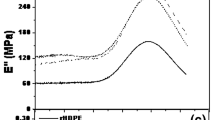Abstract
In recent times, environmental safety has been on priority in the development of new materials leading to a recycling and reuse approach to conserve the materials resources. This has resulted in more focus on the application of natural materials such as lignocellulosic fibers. This paper presents the characterization of continuous and aligned jute fabrics obtained from new and used sacks as well as the preparation and characterization of their composites incorporated into recycled polyethylene or as isolated pieces up to 40 wt%. These environmentally friendly composites were subjected to bend test and the fracture surface analyzed by SEM. The fabric from new sacks showed greater damage tolerance than that from the used sacks. The flexural stress increased steadily with increasing used fabric content up to 30 wt%, which is explained using fractographic studies on ruptured specimens. Used jute fabric composites are found to be viable alternative materials for low strength conventional materials based on cost–performance comparison with conventional materials.







Similar content being viewed by others
References
Monteiro SN, Terrones LAH, Lima AC, Petrucci LJT, d’Almeida JRM (2006) Properties of recycled polyethylene composites reinforced with discarded jute sackcloth (in Portuguese). Rev Mater 11:403–411
Monteiro SN, Lima AC, Terrones LAH, d’Almeida JRM (2007) Fabric rupture mechanism of jute sackcloth used as reinforcement in polyethylene composites. In: Proceedings of characterization of minerals, metals and materials—TMS 2007 Conference. Orlando, pp 1–3
Godfrey TA, Rossetos JN (1999) Damage growth in pre-stressed plain weave fabrics. Text Res J 68:359–370
Godfrey TA, Rossetos JN (1999) A parameter for comparing the damage tolerance of stressed plain weave fabrics. Text Res J 69:503–511
Godfrey TA, Rossetos JN (1999) The onset of tear propagation at slits in stressed uncoated plain weave fabrics. J Appl Mech 66:926–933
Satyanarayana KG, Ramos, LP, Wypych F (2009) Comparative study of Brazilian natural fibers and their composites with others. In: Thomas S, Pothan LA (eds) Natural fiber reinforced polymer composites, Kottayam, Kerala (India), vol 1. Old City Publishing Co, Philadelphia, USA, pp 473–522
Franck RR (ed) (2005) Bast and other plant fibres. Woodhead Publishing Limited & CRC Press LLC, USA, ISBN 1-85573-684-5
Callister Jr WD (2004) Materials science and engineering—an introduction, 5th edn. Wiley, New York, p 769
Bledzki AK, Reihame S, Gassan J (1996) Properties and modification methods for vegetable fibers for natural fiber composite. J Appl Polym Sci 59:1329–1336
Baley C, d’Anselme T, Guyader J (1997) Mechanical properties of natural fibers (in French). Composites 37:28–34
Mohanty AK, Misra M (1995) Studies on jute composites–A literature review. Polym Plast Technol Eng 34:729–792
Shah AN, Lakkad SC (1981) Mechanical properties of jute reinforced plastics. Fibre Sci Technol 15:41–46
Snijder MHB, Reinerink EJM, Bos HL (1998) Polypropylene and polystyrene reinforced with annual plant fibers: screening and coupling agents. In: Proceedings of the 2nd international symposium on natural polymers and composites conference. Atibaia, SP, Brazil, pp 135–138
Carter GF, Paul DE (1991) Materials science and engineering. ASM International, Metals Park
Youngquist JA (1983) Encyclopedia of composite materials and components. Wiley, New York
Monteiro SN, d’Almeida JRM, Petrucci JLT (2005) A comparative study on the performance of polymeric wastes based composite panels (in Portuguese). In: Proceedings 60th annual congress of the Brazilian society for metallurgy and materials conference. Belo Horizonte, Brazil, pp 1–9
Acknowledgments
The authors thank the support to this investigation by the Brazilian agencies: CNPq, CAPES, FAPERJ and TECNORTE/FENORTE. It is also acknowledged the permission to the use of the SEM microscope by the PEMM from COPPE/UFRJ. One of the authors (KGS) acknowledges the financial assistance provided by Araucaria Foundation, Curitiba-P, Brazil during the period of this work and the two institutions in India with which he is presently associated for their encouragement.
Author information
Authors and Affiliations
Corresponding author
Rights and permissions
About this article
Cite this article
Lima, A.C., Monteiro, S.N. & Satyanarayana, K.G. Recycled Polyethylene Composites Reinforced with Jute Fabric from Sackcloth: Part I-Preparation and Preliminary Assessment. J Polym Environ 20, 245–253 (2012). https://doi.org/10.1007/s10924-011-0373-6
Published:
Issue Date:
DOI: https://doi.org/10.1007/s10924-011-0373-6




